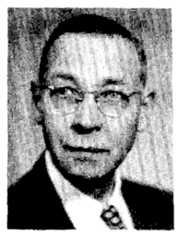John Bertrand Johnson
| Bert Johnson | |
|---|---|
|
John Bertrand Johnson (1887–1970) | |
| Born |
October 2, 1887 Gothenburg, Sweden |
| Died |
November 27, 1970 (aged 83) Orange, New Jersey, U.S. |
| Residence | United States |
| Citizenship | American |
| Fields | Electronic engineer |
| Institutions | Bell Laboratories |
| Alma mater | Yale University |
| Known for | Johnson–Nyquist noise |
| Notable awards |
Edward Longstreth Medal (1957)[1] IEEE David Sarnoff Award (1970) |
John Bertrand "Bert" Johnson (October 2, 1887 – November 27, 1970) (né Johan Erik Bertrand) was a Swedish-born American electrical engineer and physicist.[2] He first explained in detail a fundamental source of random interference with information traveling on wires.
Career
In 1928, while at Bell Telephone Laboratories he published the journal paper "Thermal Agitation of Electricity in Conductors". In electronic systems, thermal noise (now also called Johnson noise) is the noise generated by thermal agitation of electrons in a conductor. Johnson's papers showed a statistical fluctuation of electric charge occur in all electrical conductors, producing random variation of potential between the conductor ends (such as in vacuum tube amplifiers and thermocouples). Thermal noise power, per hertz, is equal throughout the frequency spectrum. Johnson deduced that thermal noise is intrinsic to all resistors and is not a sign of poor design or manufacture, although resistors may also have excess noise.
Field-effect transistor
Johnson was possibly among the first people to make a working field effect transistor, based on Julius Edgar Lilienfeld's US Patent 1,900,018 of 1928. In sworn testimony to the U.S. patent office in 1949, Johnson reported "...although the modulation index of 11 per cent is not great,...the useful output power is substantial...it is in principle operative as an amplifier".[3] On the other hand, in an article in 1964 he denied the operability of Lilienfeld's patent, saying "I tried conscientiously to reproduce Lilienfeld’s structure according to his specification and could observe no amplification or even modulation."[4]
See also
- Johnson–Nyquist noise
- Timeline of thermodynamics, statistical mechanics, and random processes
References
- ↑ "Franklin Laureate Database - Edward Longstreth Medal 1957 Laureates". Franklin Institute. Retrieved November 23, 2011.
- ↑ Johnson biography, p. 2
- ↑ Robert G. Arns, "The other transistor: early history of the metal-oxide-semiconductor field-effect transistor," Engineering Science and Education Journal, October 1998
- ↑ J. B. Johnson, "More on the solid-state amplifier and Dr. Lilienfeld," Physics Today, May 1964
External articles and references
- J. B. Johnson, "Thermal Agitation of Electricity in Conductors". The American Physical Society, 1928.
- Federal Standard 1037C and MIL-STD-188
